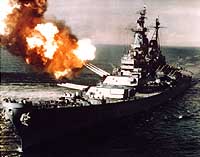
Navy surface gunnery ships were active parts of the United Nations' team that broke the North Korean army in September 1950 and chased it northwards over the next two months. Added to the guns of destroyers and cruisers that had served through the difficult Summer were battleship sixteen-inch guns, as USS Missouri (BB-63) arrived in Korean waters just in time to support the Pusan Perimeter breakout.
Missouri's one-ton shells, some six times heavier than the eight-inch projectiles of heavy cruisers, about twenty times heavier than light cruiser six-inch shells and forty times heavier than the destroyers' and cruisers' five-inchers, represented a great increase in naval gunfire's destructive potential. They also added several miles more range, an increasingly important element as the enemy retreated northward and away from the coasts. The Missouri's firepower was so useful that the Navy moved quickly to recommission three more battleships. One was almost always stationed off Korea through the rest of the conflict.
Six U.S. cruisers supported the U.N. offensive's first month, with the the light cruisers Worcester (CL-144) and Manchester (CL-83) adding their six-inch guns to the shore bombardment potential of the one light and three heavy cruisers that had been present since July 1950. With the crisis seemingly under control, Worcester and the heavy cruisers Helena (CA-75) and Toledo (CA-133) departed the area later in October. By early November, when USS Saint Paul (CA-73) arrived for combat duty, U.N. heavy ship strength was one U.S. battleship, two heavy and two light cruisers, plus a British six-inch gun cruiser.
The warships needed sophisticated gunfire control to ensure the effectiveness of shells fired from moving ships at distant and frequently hidden targets. To this end, shipboard rangefinders, radars and computing machines were supplemented by helicopter-borne spotters and specially trained shore fire control parties.
This page features pictures of and related to naval gunfire activities during the U.N. offensive period of the Korean War, from 15 September to 25 November 1950.
For views of naval gunfire and bombardment rocket support
of the Inchon Invasion, see:
For visual coverage of other aspects of the September-November
United Nations' offensive in Korea, see:
For a precis of our Korean War images, and links to more
comprehensive pictorial coverage of that conflict, see:
| If you want higher resolution reproductions than the Online Library's digital images, see: How to Obtain Photographic Reproductions. |
Click on the small photograph to prompt a larger view of the same image.
|
Photo #: 80-G-K-12603 (Color) USS Missouri (BB-63) Fires a salvo of 16-inch shells from turret # 2 while bombarding Chongjin, North Korea, in an effort to cut enemy communications, October 1950. Chongjin is only 39 miles from North Korea's northern border. This is a color-tinted version of a black & white original. The original photograph is Photo #: 80-G-421049. Official U.S. Navy Photograph, now in the collections of the U.S. National Archives. Online Image: 84KB; 740 x 605 pixels Reproductions of this image may also be available through the National Archives photographic reproduction system. |
 |
|
Photo #: 80-G-421049 USS Missouri (BB-63) Fires a salvo of 16-inch shells from turret # 2 while bombarding Chongjin, North Korea, in an effort to cut enemy communications, October 1950. Chongjin is only 39 miles from North Korea's northern border. Official U.S. Navy Photograph, now in the collections of the U.S. National Archives. Online Image: 87KB; 740 x 610 pixels Reproductions of this image may also be available through the National Archives photographic reproduction system. A color-tinted version of this black & white photograph is available as Photo #: 80-G-K-12603. |
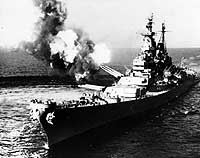 |
|
Photo #: NH 95822 USS Helena (CA-75) Fires her 8"/55 main battery guns at Chongjin, North Korea, on 12-13 October 1950. At that time, this was Helena's northernmost Korean War combat mission. Courtesy of the U.S. Naval Institute, James C. Fahey Collection. U.S. Naval Historical Center Photograph. Online Image: 94KB; 740 x 605 pixels |
 |
|
Photo #: NH 96990 USS Helena (CA-75) Buildings wrecked by the ship's eight-inch shells during a bombardment of North Korean positions, circa October 1950. The building in the foreground was the enemy communications center. That in the background was their headquarters. The bombardment was directed by Commander Lester E. Hubbell, ship's Operations Officer and member of its Shore Fire Control Party, from a Korea Military Advisory Group radio transmitting truck concealed within a few hundred yards of the target. Photograph was released by CinCPac Fleet PIO on 20 October 1950. Official U.S. Navy Photograph, from the "All Hands" collection at the Naval Historical Center. Online Image: 137KB; 605 x 765 pixels |
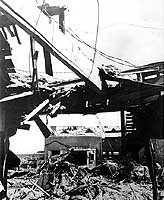 |
|
Photo #: 80-G-420809 Commander L.E. Hubbell, USN,, Operations Officer of USS Helena (CA-75), (right) Confers with Lieutenant Colonel Rollins S. Emmerich, U.S. Army, at Korean Military Advisory Group Headquarters, 19 October 1950. Helena was then providing gunfire support for the United Nations' forces offensive in Korea. Note Cdr. Hubbell's shoulder holster. Official U.S. Navy Photograph, now in the collections of the National Archives. Online Image: 128KB; 740 x 610 pixels Reproductions of this image may also be available through the National Archives photographic reproduction system. |
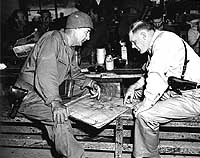 |
|
Photo #: 80-G-420319 USS Missouri (BB-63) Scene in the ship's main battery plotting room, during operations off Korea, 17 September 1950. Official U.S. Navy Photograph, now in the collections of the National Archives. Online Image: 90KB; 740 x 615 pixels Reproductions of this image may also be available through the National Archives photographic reproduction system. |
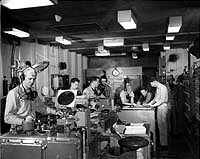 |
|
Photo #: 80-G-421187 USS Missouri (BB-63) Chief Gunner's Mate W.L. Stull (left) and Ensign R.H. Sprince relay an order to load all guns of turret one, during bombardment operations off Korea, October 1950. Official U.S. Navy Photograph, now in the collections of the National Archives. Online Image: 91KB; 740 x 620 pixels Reproductions of this image may also be available through the National Archives photographic reproduction system. |
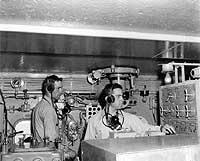 |
For views of naval gunfire and bombardment rocket support
of the Inchon Invasion, see:
For visual coverage of other aspects of the September-November
United Nations' offensive in Korea, see:
For a precis of our Korean War images, and links to more
comprehensive pictorial coverage of that conflict, see:
| If you want higher resolution reproductions than the Online Library's digital images, see: How to Obtain Photographic Reproductions. |
2 January 2000